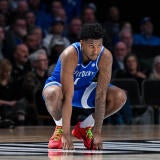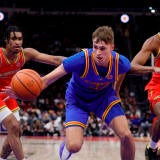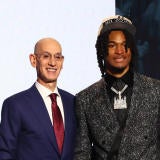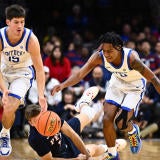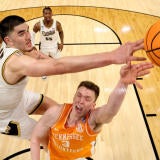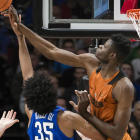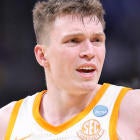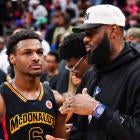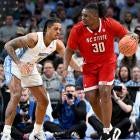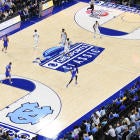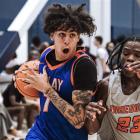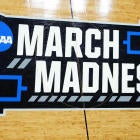PORTLAND, Ore. -- The PK80 was an out-and-out success.
College basketball got as much attention as it ever has during Thanksgiving weekend because the unprecedented 16-team event. Thanks to so many high-end programs getting invited, it also became a cornucopia for NBA personnel to fly to Portland and evaluate more prospects than ever before in one setting. All 30 NBA franchises sent multiple scouts, general managers and other personnel to the event. More than 100 evaluators were on hand to watch 24 games across three days.
With a bevy of pros populating Rip City, CBS Sports spoke to evaluators to get a sense of how PK80 helped, hurt or kept course for some of college basketball's biggest names. Here's a collective version of the feedback overheard in Portland and with follow-up phone calls since.
Marvin Bagley III, Duke
The MVP of the Motion bracket can do little wrong at this point. He's exceeded the hype, which is truly saying something. He stood out particularly in leading Duke's three second-half come-from-behind wins at PK80. He did it while playing relatively flat-lined from a demeanor standpoint.
And look out. Bagley's shooting is getting sharper by the game. Scouts said his form is "where it needs to be," and it's probably a matter of time before he turns into a reliable 3-point shooter. Bagley's knack for getting to the rim and working around the tin without the ball already are at an A-level. He averaged 27.3 points and 15.0 rebounds on 55 percent shooting.
His practice habits are also held in strong regard. Mike Krzyzweski was careful to point out that Bagley is cut from the same cloth as the type of players he's coached at the Olympics over the years. Another scout brought up the best player in the world.
"I'm by no means comparing him to LeBron James, but LeBron has that 'I want to be good' about him," the scout said. "'I'm going to eat up everything I can to be great.' Kevin Garnett was like that. This is what that kid showed me."
Against Texas and potential lottery pick Mo Bamba, Bagley had 34 points, 15 rebounds, three turnovers and just two fouls. He wasn't guarding Bamba throughout, but according to CBS Sports' tracking in the second half, he won more one-on-one battles for rebounds and scored more points on Bamba than vice-versa when the two were matched up.
"His second and third jump are as good as I've seen," one scout said.
He has almost everything an NBA team would want in a top pick. A better-than-you-think passer, a defender adapting by the game. His ability to casually put up 24-and-13 is what stands out most. Despite making it look easy, Bagley has a desire to compete and commands the ball. While there is some skepticism from some scouts over his long-term projection as a dynamite lock of a franchise player, it's almost reached the point where it would be impossible for him to fall out of the top three. Portland was truly his moment of arrival, nationally.
Trevon Duval, Duke
Still viewed as a first-round pick because of his athleticism, NBA build and playmaking ability, Duval is considered a project overall at this point, though. There was scuttlebutt in the preseason about his slow start in Duke practice, and from a shooting standpoint he's still got a long way to go.
Though their playmaking, athleticism and body control resemble each other, Duval's not a Dennis Smith-type of point guard because he does not see a move or two ahead on the floor yet. He could wind up being more of a Emmanuel Mudiay type. Duval's biggest hurdles right now are a lack of vision and an inconsistent mid- and long-range jumper. He averaged 12.3 ppg and 4.6 apg on 36.4 percent shooting at PK80.
Does he want to be a setup guy? Can he be? Can he grow out of the player he was in high school and into NBA-level starting point guard? He has the biggest hill to climb of any Duke player on 2018 draft boards. Teams don't look at him as someone who can be handed the ball at the NBA level yet and trusted to run a team (and that's OK; he's only nine games into his freshman season after all).
"When I watched John Wall at Kentucky he wasn't a very good shooter," one scout said, "but John Wall had less of a mountain to climb in terms of his form, his stroke, his release point. Trevon makes me nervous with that."
Grayson Allen, Duke
At this point, almost 3 1/2 years into his college career, he's carved out a lot of what his role will be at the next level: athletic, not a real point guard, but an energy player who will come off the bench and provide bursts of offense. He's a rally guy. His defense is still questionable but not terrible.
His position on draft boards is liable to be volatile this season and probably could have dramatically different placements depending on the team by the time we get to the 2018 Draft. Allen's 36.7 percent shooting against good competition was hard to ignore.
He still has a tendency to disappear a bit (Duke winning all three games despite Allen not shooting well on the whole was surprising), but his demeanor on the floor has been mostly good this season. As a college player, he's set up for a rewarding final season. Much of what he can and can't do at this point has been determined, so the rest of the season will go a long way to deciding if he moves from good to great with his shooting decisions, driving ability, screen-and-roll action and floor vision.
With an exceptional finish, Allen could play his way in the 20s -- but could have big bust liability there. He'll be seen as a safe pick in the 40s.
Mohamed Bamba, Texas
Bamba's length is something to behold in person. He's 7 feet tall (though I found it hard to believe he's not 7-1 after interviewing him), with huge hands and a 7-foot-9 wingspan. But he's not yet as consistently physical as his frame allows him to be.
He looked like two different players between Texas' opener vs. Butler on Thursday and at the showdown with Bagley and Duke on Friday. Unfortunately, he found himself assigned to Wendell Carter more often than Bagley. Against Gonzaga he was spotty, too, which is a rough look considering how far Bamba outpaces Zags big men Killian Tillie and Johnathan Williams III as an NBA prospect. Bamba averaged eight points, 10.7 boards and 3.7 blocks in Rip City.
Bamba wants to show he's a shooter, but it's taking a while. He took five 3-point attempts (at least one in each game) at the PK80 but failed to make one. He's got a lot of good tools on offense, but his impact falls short of what it should be given his skill level and the playmakers Texas has on the roster this season.
Bamba's rebound and shot-blocking alone will mostly get him to get in the lottery. He's too good at those areas already and those skills have a high probability of transferring to the next level. College basketball has a batch of 7-footers, of course, but no one in the college game right now is both built like Bamba and has his knack for defense. He's adroit to guard 2s and 3s 20 feet away from the hoop. Because of his up and down start, he's got the potential to make as big a jump from November to March as almost any NBA prospect that was in Portland.
Trae Young, Oklahoma
He looks small, but he's not. At 6-foot-2 and with a 6-4 wingspan, Young gets downgraded for his size some, but what's he going to look like when he's 25 years old? His frame and his body, there's something to work with there. He's got boxy shoulders and he's not a little wisp.
Moreover, he's convincing scouts that he's more than just a ball-dominant scorer. The combination of his speed and able to get his shot off, that's so valuable now. And he's already has one of the best handles in college basketball. He's also stronger than he seems at first blanch. He workout regimen is well-regarded, and he'll inevitably become a tougher player to handle once he adds 10 pounds of muscle. Evidence of dedication to his craft is obvious with how quickly he's taken to running a high-level Division I offense that's been put in place by a former NBA coach, Lon Kruger.
Young had the best showing of any player at the PK80. He's fun to evaluate because it's so obvious to see the things he does well. In Portland, Young got better with every game, displayed his super-long-range ability -- but also reminded scouts why he's a point guard at heart. Young is not hesitant to drive, and because he's a three-level (OK, more like a four-level) shooting threat, he creates on almost every possession for his teammates.
Young's 43-point outburst vs. Oregon got the biggest headlines for the Sooners, but the reality is he was impressive in every game (34.7 ppg, 6.7 apg, 5.0 rpg, 51.7 FG%). He's changed Oklahoma's outlook this season, and while he was considered a two-year prospect initially, one-and-done has to be in consideration now. He's a different kind of offensive threat than Buddy Hield, who was getting the majority of his points by playing off the ball. With Young, he's calling the shots and commanding the rock. Choosing Oklahoma was a smart move: The program needed him, and he can show off everything he can do.
Miles Bridges, Michigan State
Injury prevented deeper evaluation at PK80, but the NBA game now needs players like him. He can shoot, guard the post and play the 3 or the 4. Despite college stardom, he's probably going to be more of a complementary guy and stands in the second or maybe third tier when you look at the 2018 draft class as a whole. Guys like Bamba, Bagley and Jaren Jackson have more potential than he does. But still, his skills have value in the NBA. He plays with enthusiasm, has toughness and is athletic enough to adapt in the pros. Plus, he's made an important progression over the course of the past two years in becoming a shooting threat.
His biggest weakness is his ball handling. He'd be more of a top-tier pick and long-term NBA star if he was able to create with the dribble and beat athletic wings to the lane with it. He's not going to be doing that at the NBA level. It would be unfair to him if people started saying Draymond Green just because of the Michigan State connection. Bridges doesn't have the length or the skill base Green had, even when the Warriors star came off the bench as a freshman. Bridges is attack, attack, attack, and in some cases that's valuable but as the lead guy, no. He can be a star-level role player.
Jaren Jackson, Michigan State
The freshman forward presents very interesting case. He will be up and down this season, but remember, he just turned 18. He's almost a year younger than most guys being evaluated for the top 20. His youth has to be taken into account heavily. Even still, the leap he's taken in the past year has been remarkable. With him, right now, it's a lot of projection. He will not be the same player in March as what he's shown in November. He won't come out and average 20 and 12 like DeAndre Ayton -- that's not who he is.
Also, consider the program, consider the coach, consider the context of the team and the scheme. He's a B-plus defender at the college level already, he can make a shot from all three levels when you need it, and you can move the ball through him. What he's doing now is a staple of Tom Izzo's scheme. His physical tools are outstanding. He's engineered for the NBA: skilled, with a big wingspan and fluidity. For a player his size, he's got a very good handle and his shooting attributes project nicely.
Theo Pinson, UNC
There are split opinions on the senior swingman's chances at the next level. The shooting woes will be a scare for many, but others believe there's a place for him in the pros because he does the requisite size and skill level in most other areas. His inability to bump his college shooting numbers a few percentage points each season is the big red flag. He's also been hurt in his career a couple of times, which will be taken into account.
Still, he can definitely guard in college and figures to be an above-average defender in the pros. He's not a point guard but is a good passer and should be an energy guy in the NBA. He has a feel for the game that others in his size range lack. UNC's also in the midst of a down year in its cycle, so it's unusual to have only a player like Pinson be a prospect in a given year. Roy Wiliams is a really good coach and is probably going to put him in position to get good looks for the back half of the second round.
Gonzaga's boatload of prospects
A bevy of prospects with varying timelines on being drafted. Mark Few has turned the program into a destination spot for prospects. They have four on the roster at the moment, though it's hard to say which player is projecting best for the NBA. Killian Tillie has good size, nice skill components but didn't put on any weight from last season to now. Then again, consider Kelly Olynyk. He need three years in that system before becoming a completely different player. Tillie could go on the Olynyk plan. He plays so hard, even on the borderline of being dirty. Just can't be as thin as he is. Solid shooter, knows how to play. Those boxes being checked already help in in a big way.
Rui Hachimura is probably the prospect with the most upside, but he's got years to go on defense. His build is great, his shooting form is where it needs to be and his knack for making a big play when his team needs it is undeniable. Might be getting more minutes now than even expected. Will be fascinating to see how his season trends. Few players have a greater disparity on one side of the floor vs. the other.
Johnathan Williams III is definitely a potential NBA player and has a good shot at being picked even despite being older (23). He's got good size, a surefire motor and knows how to switch on defense. Williams has played in big games, will be physical, and that might be enough to make him a role-playing four. His shooting is rough. He won't be able to score at the next level.
Corey Kispert is also pretty good. For them to find a guy that's 6-6 with that type build as a freshman and who can shoot? It's just another great find by that coaching staff. They're continually bringing in players who either physically or from an IQ standpoint can win at the college level. Kispert's not a buzzy name yet, but wait until a year from now.


